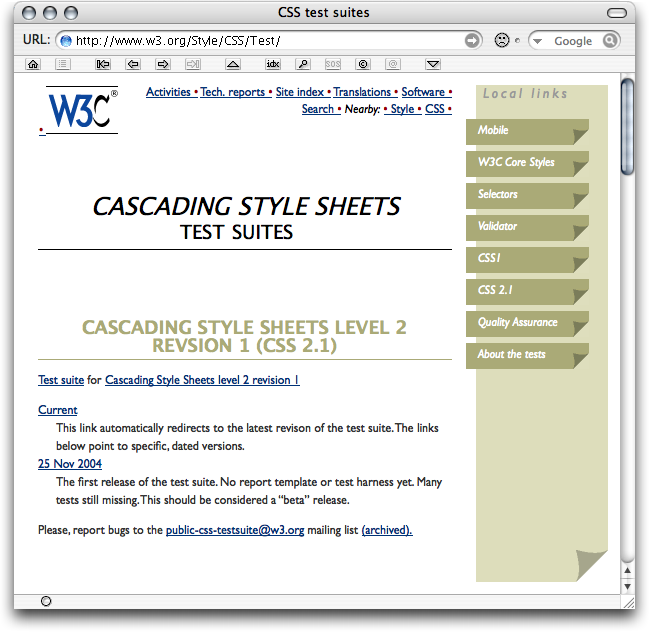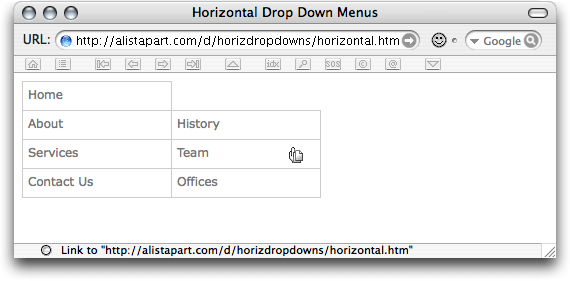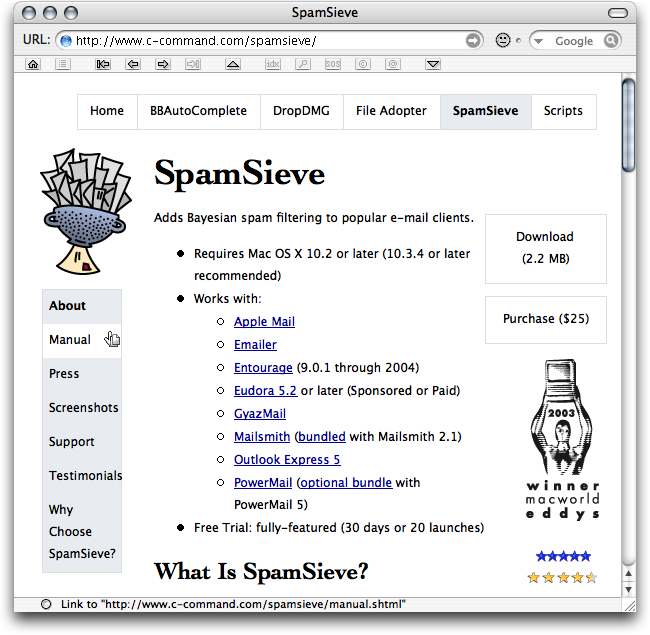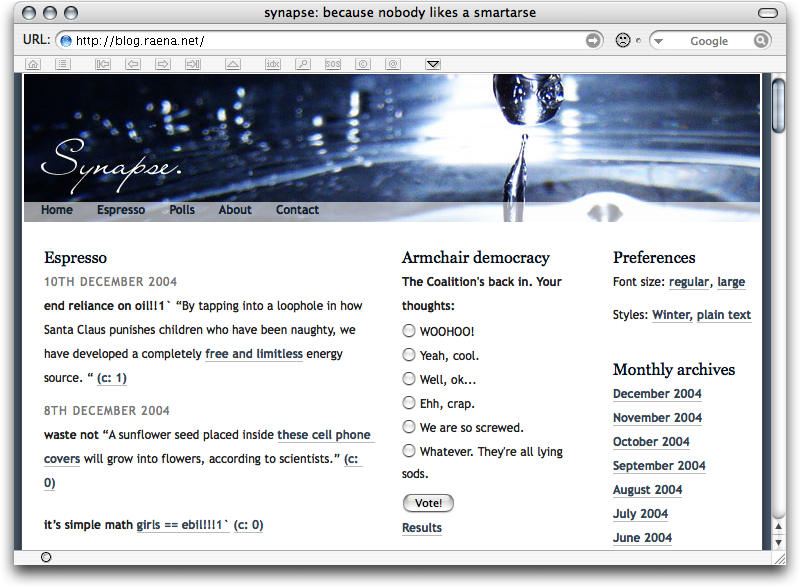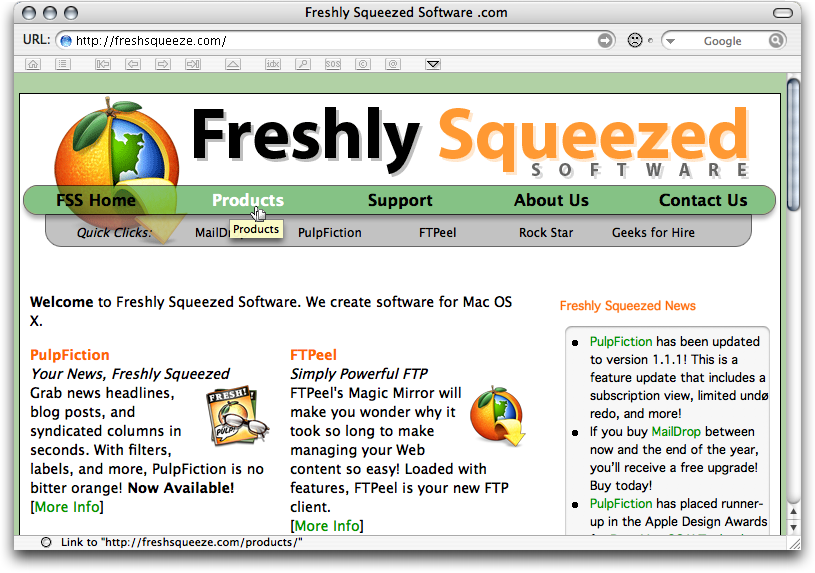Archive for December 2004
Friday, December 31, 2004
David Pogue:
The Virgin PR folks checked with the higher-ups, and reported that the Virgin player does not, in fact, have any conflict with SP2 at all. The technician, I was told, was completely wrong. The PR person hinted that perhaps I should give up the name of the technician I spoke with, so that he could be, ahem, re-informed.
Andy Hertzfeld describes the process of publishing Folklore in a book:
The next time I visited Sebastopol to work on the layout, Michelle showed me a mockup of the cover, that used a black and white Norman Seeff photo that was taken for Rolling Stone magazine in January 1984, the one where Norman told us not to smile. They had colorized the Macintosh and added a bright red background. I liked the photo but disliked the red color, and was surprised to learn that my opinion didn’t matter all that much. The O’Reilly team was adamant, telling me that I wasn’t in a good position to judge, since it was supposed to appeal to young people, a group to which I no longer belonged. Eventually they wore me down and today I even sort of like it. At least I was able to get them to change “Revolutionaries” to “Revolution,” which I thought seemed slightly more modest.
I’d always wondered why the book was titled that, because I’d just assumed that it would be Macintosh Folklore, and the final title always makes me think of Mike Swaine’s book.
Tuesday, December 28, 2004
In a sequel to last-year’s article, Electronic Gaming Monthly interviews today’s kids about classic video games (via Linked List):
EGM: What do those [Star Wars] lasers look like?
Anthony: Stars.
Garret: Fireworks.
Bobby: Fireballs.
Parker: Psychedelic snowflakes.
Dillon: It’s snowing up.
Rachel: This looks like a game out of Willy Wonka or something.
Bobby: It’s like, “I’m Willy Wonka. I’ve created a new Star Wars.”
EGM: Are the TIE fighters scary?
Anthony: No. It feels like they’re trying to give me flowers.
Dillon: But flowers that you’re allergic to, so you’re trying to blow them up.
Monday, December 27, 2004
I’m trying to clean up some URLs using mod_rewrite. I have .shtml files on the server, but I want browsers to be able to access them without the file extension. And if the browser does send a URL with .shtml, it should be redirected to the URL without the file extension. I have this much working, and here are the contents of the .htaccess file:
RewriteEngine On
RewriteBase /
# remove .shtml; use THE_REQUEST to prevent infinite loops
RewriteCond %{THE_REQUEST} ^GET\ (.*)\.shtml\ HTTP
RewriteRule (.*)\.shtml$ $1 [R=301]
# remove index
RewriteRule (.*)/index$ $1/ [R=301]
# remove slash if not directory
RewriteCond %{REQUEST_FILENAME} !-d
RewriteCond %{REQUEST_URI} /$
RewriteRule (.*)/ $1 [R=301]
# add .shtml to access file, but don't redirect
RewriteCond %{REQUEST_FILENAME}.shtml -f
RewriteCond %{REQUEST_URI} !/$
RewriteRule (.*) $1\.shtml [L]
The problem is that this doesn’t work when the URL has an anchor. If I type:
http://www.example.com/foo#bar
into the browser, it works fine. But:
http://www.example.com/foo.shtml#bar
gets redirected to:
http://www.example.com/foo
instead of:
http://www.example.com/foo#bar
As far as I know, #bar stays in the browser; it isn’t sent to
the server. So I don’t think there’s any way to preserve it using the
rewrite rules. Is there any way to get the browser to tack on the #bar after it gets the 301 from the server?
Friday, December 24, 2004
Thursday, December 23, 2004
The new iCab beta (registered users only) supports “CSS 2.0/2.1 probably more complete than most other browsers,” and it works on systems all the way back to Mac OS 8.5 (the first version to include ATSUI). The CSS support does seem to be much improved, but it was not evident to me how it’s better than in Internet Explorer 5 or Safari, and there are some areas where it’s clearly worse.
Update: I have now seen some pages that iCab renders better than IE 5. One area where iCab was noticeably worse, the failure to honor text-decoration: none, can be adjusted in the preferences.
Wednesday, December 22, 2004
Ron Avitzur (via Rentzsch):
We finished in January 1994. Graphing Calculator has been part of the Macintosh ever since. Teachers around the world use it as an animated blackboard to illustrate abstract concepts visually. It shipped on more than twenty million machines. It never officially existed.
Update (2020-09-07): See also: Avitzur’s Google TechTalk (via Dave Mark).
Graphing Calculator History Mac Mac App Math
Saturday, December 18, 2004
Eddy-winning products that I use:
- BBEdit (all day every day)
- BitTorrent (yay for PyObjC)
- Halo: Combat Evolved (haven’t played it recently, though)
- Photoshop Elements (2.0 was so good that I haven’t upgraded)
- Snapz Pro X (1.x was so good I almost didn’t upgrade)
- Toast (still doesn’t have any competition)
It looks like a great list of products. Personally, I like the Kensington StudioBoard better than the Matias Tactile Pro, and I like the EZQuest Boa better than the LaCie d2. The LaCie is more compact, but it’s slower, more expensive, and doesn’t work with Retrospect.
Thursday, December 16, 2004
Joel Spolsky:
The answer is really complicated. I’m going to start with a little economic theory, then I’m going to tear the theory to bits, and when I’m finished, you’ll know a lot more about pricing and you still won’t know how much to charge for your software, but that’s just the nature of pricing. If you can’t be bothered to read this, just charge $0.05 for your software, unless it does bug tracking, in which case charge $30,000,000 for it.
Tuesday, December 14, 2004
Greg Wilson:
Freedom of the press, different systems are best for different things, blah blah blah…I don’t buy it any more. I just want the authors of Quixote, Twisted, WebWare, and the rest to sit down, hammer out their differences, and come up with something that’s as technically and socially compelling as RubyOnRails.
Monday, December 13, 2004
Ned Batchelder has released a new version of coverage.py.
Brent Simmons:
In an alternate universe, MarsEdit is an outliner instead of a weblog editor—and its name is MarsLiner. It has the exact same icon MarsEdit has.
When I first asked Bryan to make a Mars-with-spaceship icon—way back in early 2003 (I think—could have been 2002) it was for an application named MarsLiner. The idea was to do an outliner that could fill in for MORE.
Mac Mac App MarsEdit RSS
Saturday, December 11, 2004
Adam Engst:
I just heard from Paul Findon that the petition to encourage Adobe to develop a version of FrameMaker for the Mac OS X has now exceeded 2,700 signatures.…FrameMaker remains the pre-eminent tool for writing long, structured documents. I use and like InDesign, but it’s far more of a graphical layout program than a structure publishing application.
Nicholas Riley lost data because he labelled his archive CDs.
Jerry Kindall:
How many letters of your name do you have to type into Google Suggest before your name appears on the suggestion list, and at what position does it first appear? (If your name is the only thing on the list, you get position zero as a bonus.) Write the results as “8.4” (you have to type 8 letters, and your name appears first at position #4).
My number is 9.3, which I guess is pretty good considering that my first name is rather long and common:
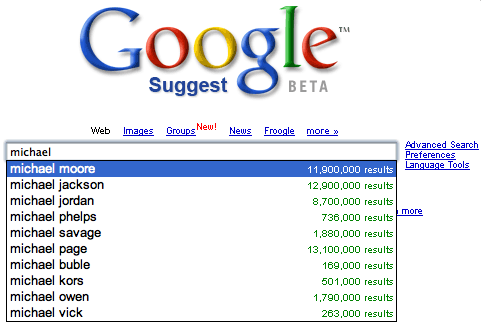
And I bet Moore, Jackson, and Jordan, etc. don’t have Erdös Numbers…
Dan Crevier got a patent from his work on Mac Outlook Express:
The system and method of the present invention automatically provides dynamically generated completion information for facilitating user input of e-mail addresses or contact information. This completion information is developed from a “data store” comprised of multiple data sources such as previously sent or received e-mail, and other types of electronic files such as word processor or spreadsheet files. The present invention monitors and uses the information in the data store to automatically store, track, maintain, and organize data entries in a dynamic “resolution list.” As a user begins to input an e-mail address or contact, the present invention can either automatically complete the entry using a most probable result from the resolution list, or can display a list of likely matches from which the user may select the desired e-mail address or contact.
Hopefully, I’m just bad at reading patents, because it sounds like a lot of current programs—from Mail to LaunchBar—might be covered by this.
Thursday, December 9, 2004
Gus Mueller:
Part of the reason I’m writing this is so I can look back in a couple of years and think to myself “Wtf was I doing that for? Was I really that much of a moron?” and maybe get a chuckle out of it. That comes to mind sometimes when I look over old code I’ve written.
Tuesday, December 7, 2004
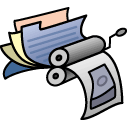 DropDMG 2.5 adds support
for Panther’s Zip format, StuffIt X, device images, and various flavors
of tar archives. Other
new features include custom icons, named configurations, and a
system service.
DropDMG 2.5 adds support
for Panther’s Zip format, StuffIt X, device images, and various flavors
of tar archives. Other
new features include custom icons, named configurations, and a
system service.
DropDMG ZIP Archive
Sunday, December 5, 2004
TN2124:
This technote describes a number of ‘secret’ debugging facilities in Mac OS X, including environment variables, preferences, routines callable from GDB, special files, and so on. If you’re developing for Mac OS X, you should look through this list to see if you’re missing out on something that will make your life easier.
Friday, December 3, 2004
Eric Blair:
So I got my package of iPod Socks from Apple yesterday. They’re nice, but not exactly what I was expecting.
Wednesday, December 1, 2004
The December issue of ATPM is out:
